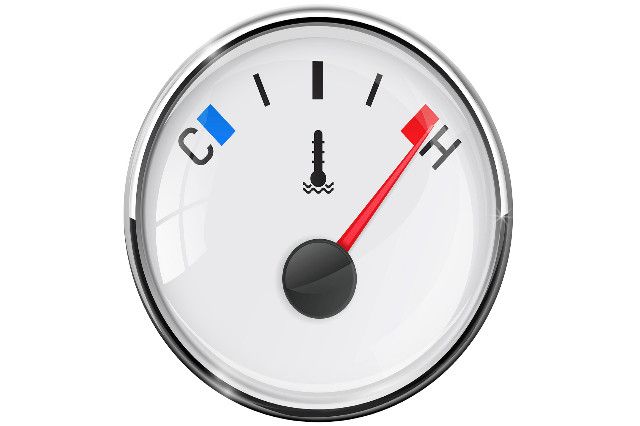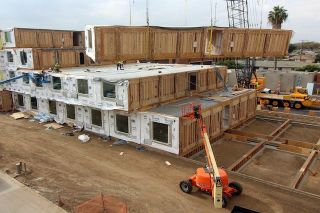
www.buildingsandcities.org/insights/commentaries/lomas-overheating-in-new-homes.html
Overheating in New Homes: A New Design Tool

Kevin Lomas explains why the risk of overheating in homes is an increasing problem in the UK and elsewhere - in both existing buildings but also for the construction of new dwellings.
To address this public health problem, a ground-breaking new tool has been developed and launched to assist designers, planners and clients to identify and reduce the risk of summer overheating in dwellings. A key benefit is its simplicity, early application in the design process, potential to inform design strategies and the provision of supporting background information and guidance. Further uses are envisaged, for example to identifying properties and rooms at risk of overheating - for public health compliance as well as education and training. Although this tool was developed for use primarily in the UK, it should inspire others around the world to take similar action.
Summertime overheating in UK dwellings (and many other places worldwide) is widespread and increasing. The UK government's Environmental Audit Committee (HMG, 2018a) estimates that around 20% of UK homes overheat. This affects people's health and well-being especially the young and elderly. In the European heatwave of 2003, there were 2200 heat-related deaths in the UK in just 10 days and an estimated additional 15,000+ premature deaths across Europe. As the country warms, heat waves will become longer, more frequent, and more intense. The Committee estimates that 'there will be 7,000 heat-related deaths every year in the UK by 2050 if the Government does not take action'. Overheating also has more subtle effects: it leads to degraded sleep which impacts on people's health and wellbeing. Given the imperative not to increase energy demand in buildings, the introduction of air conditioning in temperate climates must be avoided. But this raises some important questions, what actions should be taken, by whom, when and where?
The overheating problem is being compounded as we continue to build new homes that will overheat (Lomas and Porritt, 2017); and this may be exacerbated by the UK's Industrial Strategy. As one of its three strategic areas, the Construction Sector Challenge, is pushing 'Offsite manufacturing technologies' …. 'to minimise the wastage, inefficiencies and delays' …. 'speeding up construction and reducing disruption' (HMG, 2019). This move to so-called 'modern methods of construction', an epithet that might equally well have been used for the pre-fabrication/industrialisation/system-build initiatives of the past, can bring with it many unintended consequences. Stuart Green's commentary in Buildings and Cities (Green, 2019) identifies undesirable consequences for the economy, construction industry, local employment and house buyers. The concern here is the added risk of summertime overheating that comes with well-insulated, thermally lightweight, low-cost construction methods (e.g. Lomas and Porritt, 2017; HMG, 2018b); especially when used to build flats and apartments (e.g. ZCH, 2015).
Prevention by regulation is one approach, and regulatory change has been called for by the Committee on Climate Change (CCC, 2015; HMG, 2018b). However, changes to building regulations take a long time and firm intent is often weakened in the consultative process. Furthermore, regulatory enforcement can be unreliable, especially in new and complex matters such as overheating. Advice and guidance can help (e.g. ZCH, 2015; NHBC Foundation, 2012a, 2012b) but such advice is often qualitative, and it is difficult for designers and construction companies to know exactly what is needed, when and how. Neither is there a solid foundation on which to anchor and defend decisions, for example in the face of cost cutting, so-called value engineering, and other necessary design compromises. Modelling can help to predict the likelihood of overheating, but the SAP Appendix P method is unreliable (BRE, 2013) and dynamic thermal modelling is time consuming and too costly for housebuilders.
Fortunately, the Good Homes Alliance (GHA) has stepped up to the challenge by producing its Early Stage Overheating Risk Tool (GHA, 2019). The tool, which is free and open access, adopts a scoring approach similar to the credit-based system of, for example, BREEAM (BRE, 2016). The tool lists the features that tend to increase the likelihood of overheating (in red, negative) and the features that tend to reduce the risk (in green, positive). The features listed are all well-known factors, but the benefit is seeing them clearly listed on a single sheet of paper. The crucial additional component is that each feature (red or green) has an associated score. What matters here is the relative magnitude of the positive and negative scores. Thus, for example, a glazing ratio on a sun-facing façade of over 65% scores +12, but the shading thereof, even fully (which might not be structurally possible), scores -6. The clear message being, oversized glazing cannot be ameliorated by shading (Fig. 1).

Figure 1: Excerpt from the Good Homes Alliance tool for identifying and mitigating overheating risk.
Scores, both positive and negative, are provided for geography and local context (UK region, urban heat island or rural); site characteristics (do noise pollution or security concerns act as barriers to window opening, or do blue/green infrastructure or pale surfaces cool the surroundings); design (are the homes flats? with community heating? Thermally lightweight? Or have low ceilings?); and finally, solar gain and ventilation (window-to-wall ratios, cross - or single sided ventilation, designed (self) shading, and window opening areas). The total net score from the 8 (positive) risk factors and 7 (negative) mitigating factors, is then determined, and a traffic light system used to indicate the overheating risk, 12 or more and the risk is high, 8 or less and the risk is low.
It is the relative scores and simplicity of the tool that are so appealing for a design team. It gives designers and others a clear vocabulary of factors that affect overheating and guidance on their interactions. For the first time, it provides them with a clear and simple framework within which to think about this complex problem. The scores show what is more, or less, important and so where to focus attention. One may readily imagine a team debating the design options with everyone equally able to understand the relative consequences of the decisions made. Is design option A better than option B, and by how much? If we replace feature X by feature Y, why how much will the overheating risk change?
For proponents of blue/green infrastructure, the low mitigation scores might be disappointing, likewise for the provision on night-ventilated thermal mass. Indeed, a bad design on a noisy, polluted site cannot be 'retrieved' even if all possible mitigations measures could be implemented.
Behind each section of the overheating risk tool there is the guidance. This explains why an issue is important, how to decide on a score, how to mitigate the overheating risk (i.e. reduce positive scores). It explains for example how to improve window designs, implement effective shading or provide secure ventilation. The associated images are very helpful. If there is one small criticism it is that this part of the tool is under-developed. This guidance and exemplar section has a valuable educational role to play, and one could readily see it expanding into a fully-fledged overheating design guide, somewhat like the passive solar design guides of the past (Yannas, 1994).
The tool might have wider applications than its current billing as an early stage design tool for new dwellings suggests. One might, for example, imagine it as an aid to social housing providers, local councils or private landlords. They could triage their existing building stocks to pinpoint spaces and buildings at risk of overheating. It would help them to critique any proposed new builds they intend to commission. One also wonders if it could also assist inspectors to operate the 'excess heat' section of the Housing Health and Safety Rating System (HHSRS) more effectively (DCLG, 2006). Presumptions built into the tool, for example about the insulation standard of the dwelling and other features might have to change, but the overall principle could have utility. As an academic, I can also see the tool assisting in the training of architecture students.
Overheating is now recognised as a serious risk in new homes and one that climate change and the UK Government's current construction strategy will make worse. The GHA is to be highly commended for their initiative by providing their clear and concise overheating design tool. This is a good example of how the research community can effectively underpin and support practice. The robust body of knowledge about overheating brought this issue to the attention of government and civil society. It is a great credit to GHA and similar organisations that they had positive engagement with this. Although this tool was developed for use primarily in the UK, it is hoped that it will inspire others around the world to take similar actions.
References
BRE (2013) Energy Follow-up Survey, 2011: Report 7: Thermal comfort and overheating. UK Building Research Establishment for the Department of Energy and Climate Change, Section 3.2.5, BRE Report No. 287472, 31pp. https://assets.publishing.service.gov.uk/government/uploads/system/uploads/attachment_data/file/414600/7_Thermal_comfort.pdf
BRE (2016) BREEAM Refurbishment Domestic Buildings, Technical Manual: Version: SD5077 - Issue:2.2 - Issue Date:29/02/2016. Watford: Building Research Establishment.
CCC (2015) Reducing emissions and preparing for climate change: 2015 Progress Report to Parliament Summary and recommendation, Presented to Parliament pursuant to sections 36 and 59 of the Climate Change Act 2008. London: Committee on Climate Change. https://www.theccc.org.uk/publication/reducing-emissions-and-preparing-for-climate-change-2015-progress-report-to-parliament/
DCLG (2006) Housing Health and Safety Rating System Guidance for Landlords and Property Related Professionals. London: Department for Communities and Local Government. ISBN 9781851128563. https://www.gov.uk/government/publications/housing-health-and-safety-rating-system-guidance-for-landlords-and-property-related-professionals
GHA (2019) Overheating in New Homes: Tool and guidance for identifying and mitigating early stage overheating risks in new homes. London: Good Homes Alliance. https://goodhomes.org.uk/wp-content/uploads/2019/07/GHA-Overheating-in-New-Homes-Tool-and-Guidance.pdf
Green, S. (2019) Modern Methods of Construction: Unintended Consequences, Buildings and Cities, [commentary]. https://www.buildingsandcities.org/insights/commentaries/modern-methods-of-construction.html
HMG (2018a) Heatwaves: adapting to climate change, Environmental Audit Committee. London: Her Majesties Government, 26 July. https://publications.parliament.uk/pa/cm201719/cmselect/cmenvaud/826/82603.htm
HMG (2018b) Ministers dragging their feet on action to protect people from heatwaves, Commons Select Committee. London: Her Majesties Government, 24 October. https://www.parliament.uk/business/committees/committees-a-z/commons-select/environmental-audit-committee/news-parliament-2017/heatwaves-government-response-published-17-19/
HMG (2019) Policy Paper: Construction Sector Deal. London: Her Majesties Government, July. [Available at: https://www.gov.uk/government/publications/construction-sector-deal/construction-sector-deal]
Lomas KJ and Porritt SM (2017) Overheating in buildings: lessons from research. Building Research & Information, 45(1-2), pp 1-18. ISSN 0961-3218. Doi:10.1080/09613218.2017.1256136.
NHBC Foundation (2012a) Understanding overheating - where to start: an introduction for house builders and designers (NF44). Milton Keynes: NHBC Foundation. https://www.nhbcfoundation.org/publication/understanding-overheating-where-to-start/
NHBC Foundation (2012b) Overheating in new homes: a review of the evidence (NF46). Milton Keynes: NHBC Foundation. https://www.nhbcfoundation.org/publication/overheating-in-new-homes/
Yannas S (1994) Solar Energy in Housing Design, Vol 1: Principles, Objectives, Guidelines. London: Architectural Association (on behalf of the Dept of Trade and Industry). ISBN 1-870-890-36-1, pp 30-37, pp 49-99.
ZCH (2015) Overheating in Homes the Big Picture, Full Report. Zero Carbon Hub. [No longer available online.]
All references accessed 23.10.2019.
Latest Peer-Reviewed Journal Content
Acceptability of sufficiency consumption policies by Finnish households
E Nuorivaara & S Ahvenharju
Key factors for revitalising heritage buildings through adaptive reuse
É Savoie, J P Sapinski & A-M Laroche
Cooler streets for a cycleable city: assessing policy alignment
C Tang & J Bush
Understanding the embodied carbon credentials of modern methods of construction
R O'Hegarty, A McCarthy, J O'Hagan, T Thanapornpakornsin, S Raffoul & O Kinnane
The changing typology of urban apartment buildings in Aurinkolahti
S Meriläinen & A Tervo
Embodied climate impacts in urban development: a neighbourhood case study
S Sjökvist, N Francart, M Balouktsi & H Birgisdottir
Environmental effects of urban wind energy harvesting: a review
I Tsionas, M laguno-Munitxa & A Stephan
Office environment and employee differences by company health management certification
S Arata, M Sugiuchi, T Ikaga, Y Shiraishi, T Hayashi, S Ando & S Kawakubo
Spatiotemporal evaluation of embodied carbon in urban residential development
I Talvitie, A Amiri & S Junnila
Energy sufficiency in buildings and cities: current research, future directions [editorial]
M Sahakian, T Fawcett & S Darby
Sufficiency, consumption patterns and limits: a survey of French households
J Bouillet & C Grandclément
Health inequalities and indoor environments: research challenges and priorities [editorial]
M Ucci & A Mavrogianni
Operationalising energy sufficiency for low-carbon built environments in urbanising India
A B Lall & G Sethi
Promoting practices of sufficiency: reprogramming resource-intensive material arrangements
T H Christensen, L K Aagaard, A K Juvik, C Samson & K Gram-Hanssen
Culture change in the UK construction industry: an anthropological perspective
I Tellam
Are people willing to share living space? Household preferences in Finland
E Ruokamo, E Kylkilahti, M Lettenmeier & A Toppinen
Towards urban LCA: examining densification alternatives for a residential neighbourhood
M Moisio, E Salmio, T Kaasalainen, S Huuhka, A Räsänen, J Lahdensivu, M Leppänen & P Kuula
A population-level framework to estimate unequal exposure to indoor heat and air pollution
R Cole, C H Simpson, L Ferguson, P Symonds, J Taylor, C Heaviside, P Murage, H L Macintyre, S Hajat, A Mavrogianni & M Davies
Finnish glazed balconies: residents' experience, wellbeing and use
L Jegard, R Castaño-Rosa, S Kilpeläinen & S Pelsmakers
Modelling Nigerian residential dwellings: bottom-up approach and scenario analysis
C C Nwagwu, S Akin & E G Hertwich
Mapping municipal land policies: applications of flexible zoning for densification
V Götze, J-D Gerber & M Jehling
Energy sufficiency and recognition justice: a study of household consumption
A Guilbert
Linking housing, socio-demographic, environmental and mental health data at scale
P Symonds, C H Simpson, G Petrou, L Ferguson, A Mavrogianni & M Davies
Measuring health inequities due to housing characteristics
K Govertsen & M Kane
Provide or prevent? Exploring sufficiency imaginaries within Danish systems of provision
L K Aagaard & T H Christensen
Imagining sufficiency through collective changes as satisfiers
O Moynat & M Sahakian
US urban land-use reform: a strategy for energy sufficiency
Z M Subin, J Lombardi, R Muralidharan, J Korn, J Malik, T Pullen, M Wei & T Hong
Mapping supply chains for energy retrofit
F Wade & Y Han
Operationalising building-related energy sufficiency measures in SMEs
I Fouiteh, J D Cabrera Santelices, A Susini & M K Patel
Promoting neighbourhood sharing: infrastructures of convenience and community
A Huber, H Heinrichs & M Jaeger-Erben
New insights into thermal comfort sufficiency in dwellings
G van Moeseke, D de Grave, A Anciaux, J Sobczak & G Wallenborn
'Rightsize': a housing design game for spatial and energy sufficiency
P Graham, P Nourian, E Warwick & M Gath-Morad
Implementing housing policies for a sufficient lifestyle
M Bagheri, L Roth, L Siebke, C Rohde & H-J Linke
The jobs of climate adaptation
T Denham, L Rickards & O Ajulo
Structural barriers to sufficiency: the contribution of research on elites
M Koch, K Emilsson, J Lee & H Johansson
Disrupting the imaginaries of urban action to deliver just adaptation [editorial]
V Castán-Broto, M Olazabal & G Ziervogel
Nature for resilience reconfigured: global- to-local translation of frames in Africa
K Rochell, H Bulkeley & H Runhaar
How hegemonic discourses of sustainability influence urban climate action
V Castán Broto, L Westman & P Huang
Fabric first: is it still the right approach?
N Eyre, T Fawcett, M Topouzi, G Killip, T Oreszczyn, K Jenkinson & J Rosenow
Social value of the built environment [editorial]
F Samuel & K Watson
Understanding demolition [editorial]
S Huuhka
Data politics in the built environment [editorial]
A Karvonen & T Hargreaves



Latest Commentaries
Decolonising Cities: The Role of Street Naming
During colonialisation, street names were drawn from historical and societal contexts of the colonisers. Street nomenclature deployed by colonial administrators has a role in legitimising historical narratives and decentring local languages, cultures and heritage. Buyana Kareem examines street renaming as an important element of decolonisation.
Integrating Nature into Cities
Increasing vegetation and green and blue spaces in cities can support both climate change mitigation and adaptation goals, while also enhancing biodiversity and ecological health. Maibritt Pedersen Zari (Auckland University of Technology) explains why nature-based solutions (NbS) must be a vital part of urban planning and design.